Piano and guitar are the most popular instruments that people tend to want to learn. If you can’t find a piano in a song, there is probably a guitar, and if neither of these two things are in the song, you can bet money that it was at least programmed with a MIDI keyboard like the Arturia KeyLab 49 MKII.
In much of popular music for the 20th and 21st centuries, the guitar was probably the most dominant instrument mostly due to the way that it looked and sounded, but also for its portability. While the guitar may look cooler and be easier to carry around, there are some obvious advantages to the piano, one being the relative simplicity of it.
The piano is easier to learn in the beginning because all 12 notes are found equally distributed across the instrument, unlike the guitar, where they’re laid out in different order across 6 strings. While it may be easier to start on the piano, becoming an expert on both is equally difficult.
The piano is easy once you can clearly see how it is set up and understand the relationships between the 12 notes. You can easily see key signatures, scales, chords, and melodies on piano keys, but these relationships are harder to see on the guitar. The main reason the guitar is more complex is that there’s no pattern clearly marked (with the exception of the fret markers). You have to memorize notes on every string based on each string name. Let’s talk more about that now.
Why Learning The Piano Is Easier Than The Guitar
1) On Piano the 12 Notes Are Equally Distributed
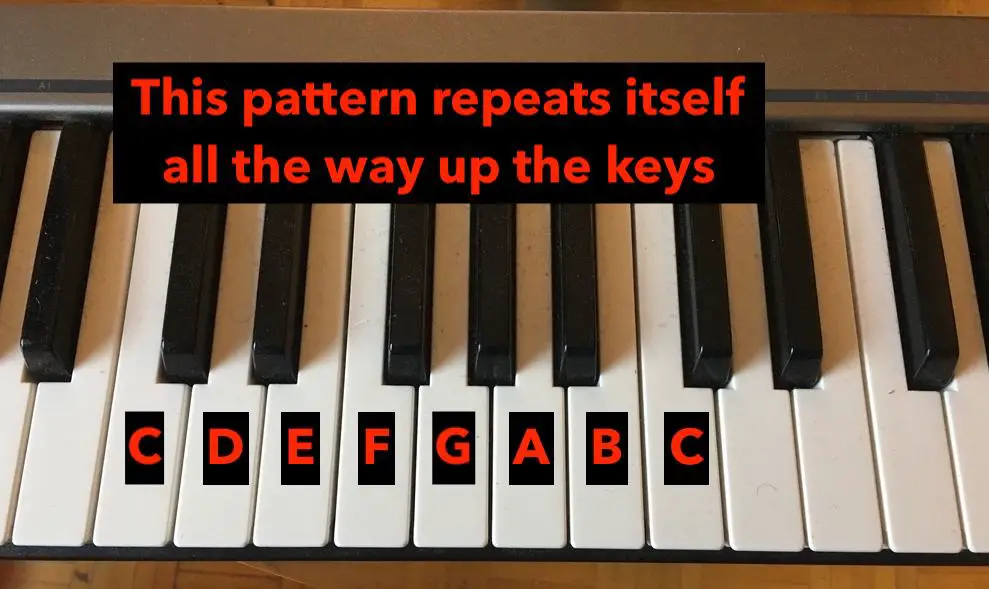
When you look at the top of a piano, you can see white and black keys in a particular pattern that repeats itself (more on this in my other article). The white keys are separated by groups of 2 and 3 black keys. Within this pattern are only 12 reoccurring notes, set up side by side and then repeated in octaves.
What makes the piano special is this very pattern. Once you know the 12 notes including the main natural 7 notes and then the accidentals (sharps and flats), the mystery of the piano disappears instantly. You just have to know the notes C-C as it’s pictured above, and then the sharps and flats that are marked by the black keys.
From there, a player can develop an ear to understand where those notes are in the octaves (C1, C2, C3, etc). The guitar is an entirely different story because those same 12 notes are spread across 6 different strings, and the pitch of each string is tuned differently.
Because each string is tuned differently, the order of notes, including the sharps and flats, changes with each string with the exception of the Low E and High E strings.
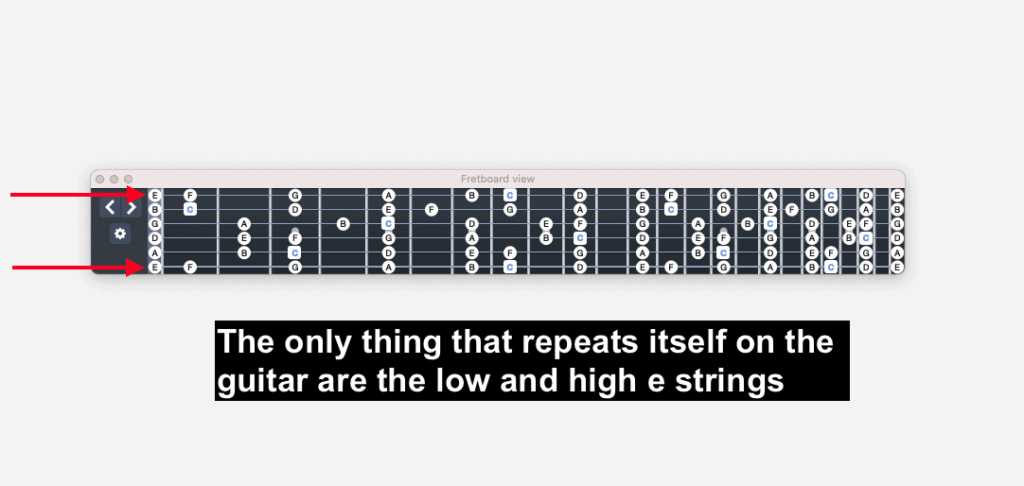
Their notes are in chromatic order like the piano, but they are also stacked up in small patterns because, as I said, each string is set up differently. Once you find where to start, you can count out each note while moving up and down strings.
The only true markers you have for a guitar note are the fret markers, the tiny dots in the middle of the neck across the entire fretboard, which are all different notes.
However, the perks of knowing the notes of the fretboard by heart disappear almost instantly once you tune the guitar in a slightly different way.
For example, if you tune your guitar to D standard, DADGAD, or any other altered tuning, you’ll have to accommodate for that when recalling what note it is.
The harder the tuning, the harder it is to remember what note you’re playing. Put simply, the piano is easier to learn, mainly because of the way it’s set up.
You can go down the keys and press all the Cs once you’ve found just one C. The guitar is a lot more complicated because you have to know each starting note on the fretboard.
Although once you’ve found a specific note on the guitar, the octave is usually easy to find, then you have two of the same notes. There are a few other ways to remember the notes of the fretboard as well including the CAGED system among others.
2) Key Signatures and Scales Are Easier to See On Piano
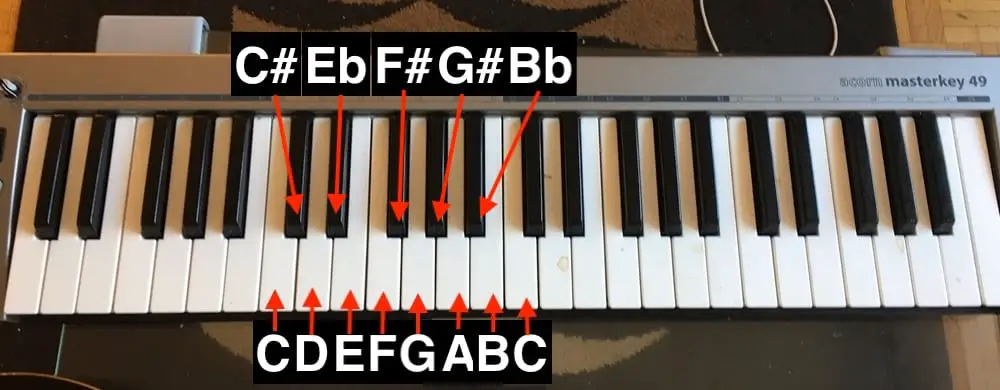
A key signature is a particular pattern of sharps and flats which are also called accidentals. It allows composers to write music without needing to constantly add accidentals to every single note on the staff.
Just like people, a person’s signature belongs to them and only them, and the same thing can be said for the key too.
A key signature has its own pitch and octave range, and it’s indicated by the accidentals at the start of the staff before the notes begin.
The order of sharps and flats lets you know what key you’re in, and there are many different ways of remembering them which I’ve talked about in my article on how to memorize key signatures.
If you can recognize the number of sharps or flats for each key, then you’ll automatically know the key signature just by looking at the beginning of the staff.
To find a key signature on a piano, all you have to do is look for a specific note and then play the notes of the major scale up from that note. This is one of the reasons why I state that piano is a good idea for any musician to learn, at least the fundamentals.
So how does this relate to the difficulty of the guitar compared to the piano? It’s very relevant because it’s incredibly easy to identify the note on the piano and then play the notes of the major scale up from that note, compared to the guitar, where you have to first identify the note, and then play the notes up from there.
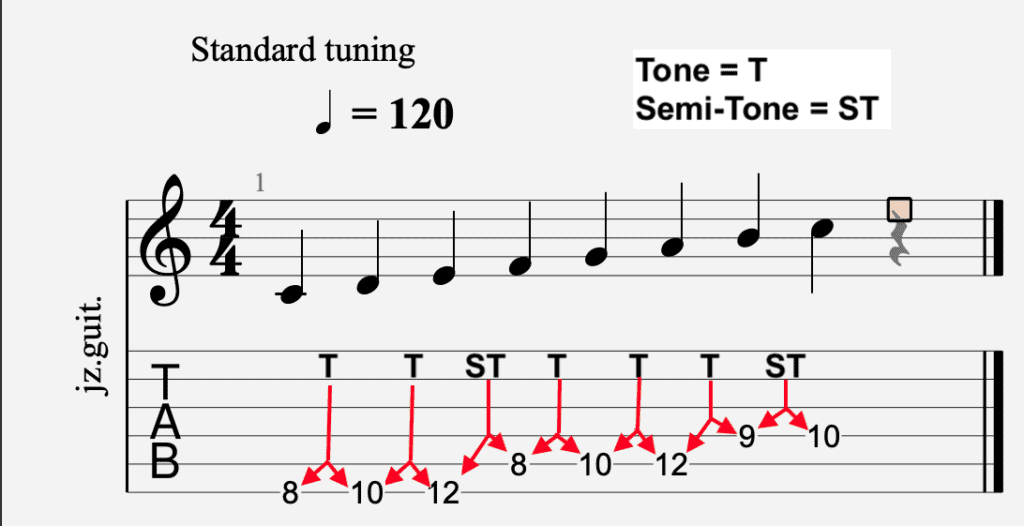
One way of getting around this is to know the order of semi-tones and tones of the scale, one of which is shown in the image above, but most guitarists tend to learn things in patterns and movable shapes.
A guitarist who goes about it in this way has to learn and memorize the shapes vertically and horizontally.
3) Easier to Count Intervals Between Notes
![Wholes - Is the Piano Easier Than Guitar [ANSWERED]](https://travelingguitarist.com/wp-content/uploads/2021/09/Is-the-Piano-Easier-Than-Guitar-ANSWERED-.jpg)
Intervals are an incredibly important part of music theory because they’re essential for identifying and forming chords and tonalities (my guide on the importance of other features like bass).
You have major, minor, perfect, diminished, and augmented intervals, and understanding and knowing these are very helpful.
Because of the reasons we’ve already explored above, it’s easy to see where these intervals are on the piano because we can see all of the notes from what I would call a bird-eyes-view perspective.
Using the Lydian mode, for example, if wanted to turn a C Major Scale into a C Lydian Scale, we would just have to sharp the 4th note of the scale.
In effect, that would give us the notes of G Major but re-ordered so that the C comes first. C Lydian is just the C Major Scale but with an F# (it’s also the 4th mode of G Major).
What’s so nice about the piano is that we can clearly see how to go about creating this scale. Let’s take a look at the image below as an example:
![Augmented 4th - Is the Piano Easier Than Guitar [ANSWERED]](https://travelingguitarist.com/wp-content/uploads/2021/09/Augmented-4th-Is-the-Piano-Easier-Than-Guitar-ANSWERED-2.jpg)
The Augmented 4th, as the image shows, is the interval in the context of the major scale that creates the Lydian sound.
Learning and then applying these concepts to the keyboard is just so much easier because all you have to do is count up from the root note to get the numerical value, ie, “4th, 5th, 3rd,” etc.
And then understand the tonality of the interval based on one’s knowledge of key signatures and major/minor scales.
Applying music theory concepts to the guitar is undoubtedly similar, but the takeaway point here is that it’s just easier to identify and apply these concepts on an instrument where the notes are spread out in a clearly visible way.
This brings me to chord construction, which is probably my favourite aspect of the piano.
4) Easier to See and Construct Chords
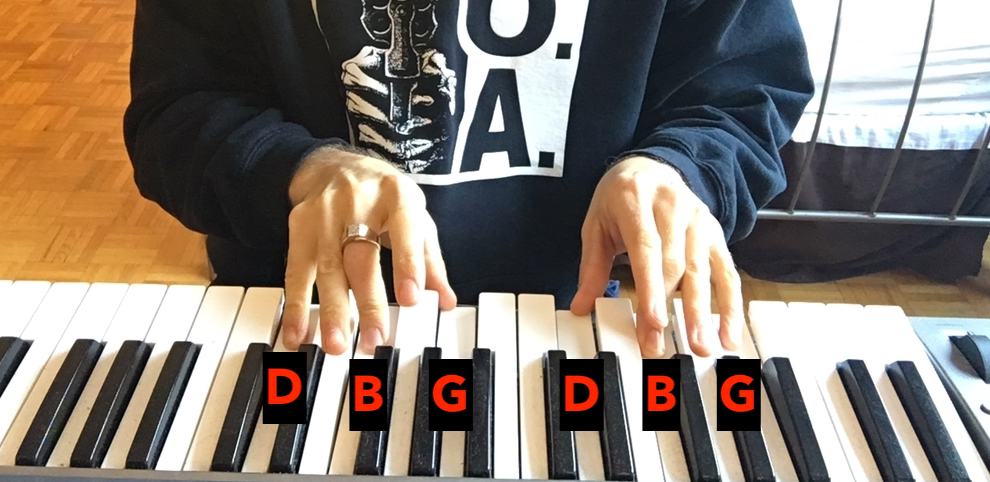
Chords are formed from scales, but you only play a few notes of the scale, and you play them simultaneously instead of one at a time. Another way of saying this is that the notes of the chords are played harmonically rather than melodically.
If you know that a Major Chord is comprised of the Root Note, major 3rd, and perfect 5th, you can easily count out 1, 3, and 5 from the starting note.
With piano, you literally can count to 5 and see where 1, 3, and 5 are. You’ll have to know what that looks like for every key and how to move freely between them, but they are pretty easy to learn.
On a guitar, you can quickly learn the shapes of certain chords, but you also have to memorize every note to be in the right key. On piano, a C looks the same in all seven octaves, on guitar, you have over 10 places to play a C chord, but finding them is much harder than on the piano.
5) The Piano is Physically Easier To Play Than The Guitar
![Guitar and Piano - Is Piano Harder Than Guitar [ANSWERED]](https://travelingguitarist.com/wp-content/uploads/2021/09/Copy-of-Untitled.jpg)
When you are learning guitar, you quickly learn about hand fatigue. The force you have to give to press the strings for a proper note is a lot more than pressing a weighted key on the piano.
You also will get callouses on your fingers from playing (my article on this) and for many beginners, they have to take a couple of days off to actually allow their fingers to get used to the pressure.
The only physical thing about playing the piano is you may get tired of sitting. It is a workout for your fingers, but you’ll never get calluses, and your hands will just get stronger. For guitar playing, you’ll need to develop hand-eye coordination and also hand synchronization.
There has to be total harmony between the picking hand and fretting hand, otherwise, you won’t be able to get it right.
These are two different techniques. What the picking hand does is very different from what the fretting hand does in contrast to the piano where both hands are utilized in the same way. This brings me to my next point.
6) Piano Has its Own Accompaniment
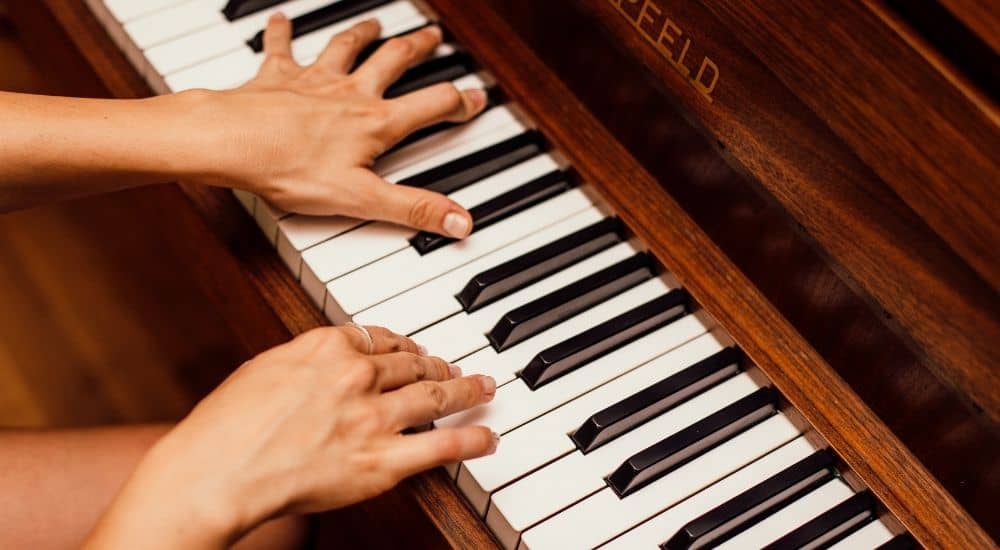
The piano is set up so that the player can use both hands to make a song. The left-hand handles all the bass notes, and the right-hand handles all the treble notes, for the most part.
Using both hands simultaneously forms accompaniment that you can use for a complete song.
With guitar, it’s possible to have two things going on at once, but you would have to be skilled to pull it off.
Hendrix famously combined rhythm and lead guitar in a way that was revolutionary while incorporating things like feedback into his playing style (more in lead guitar in my other article).
Other guitarists like Andy McKee combined percussive elements to the guitar as well.
It’s possible to play the guitar similarly in the sense that you can slap the body like a drum to mimic a rhythm section; you can use altered tunings and tapping to imitate more than one instrument, or you can use volume swells to imitate an organ.
Add things like Looper Pedals such as the RC-5 and a lot can be done with the guitar as well.
However, the difference here is that the piano is created with accompaniment and wholeness in mind.
Not only that but standard notation has been crafted with the piano as its foundation (left hand = bass clef, right hand = treble clef).
7) Piano is Easier to Sound Good as a Beginner
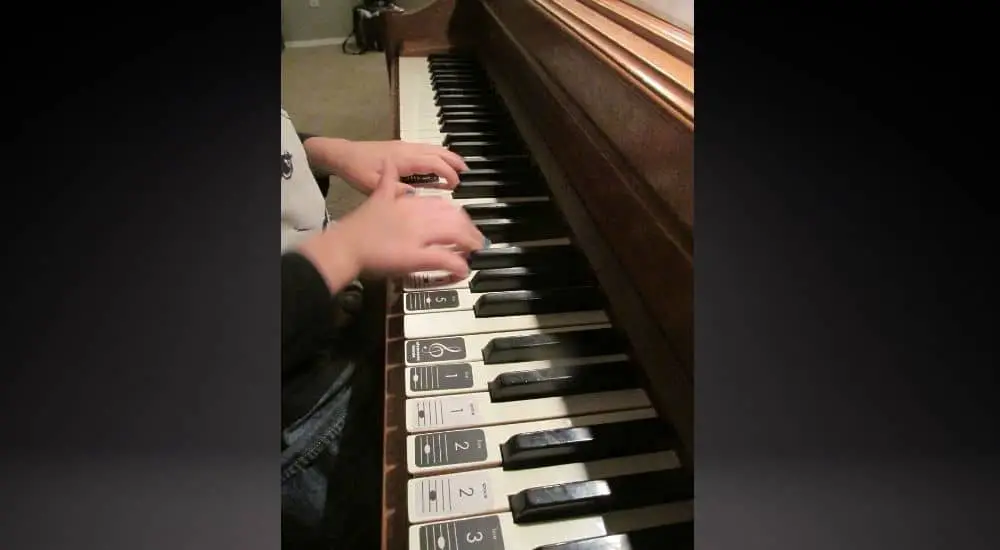
Anyone who has played both instruments knows that making a good-quality sound from a piano isn’t hard. A guitar, however, is a little more complicated.
Both the piano and guitar have to be tuned to get any good sound from it, but you don’t have to tune a piano nearly as often as you would with a guitar (you can tune one with the other too with my guide).
You also don’t have to set your fingers just perfectly on every fret and strum the notes with your other hand to get a good sound, as you do with the guitar. A lot of beginners struggle with fretting notes so much that they develop a habit where they fret the notes too hard.
This isn’t really an issue on the piano. On the piano, you either hit the key with enough force or you don’t. It’s possible to mess up the fretting of even one single note on the guitar.
Should I Learn Piano or Guitar First?
I, like many others, learned to play the piano first as a kid, and then I graduated to the guitar when I was 11 or 12 years old.
If I had to do it all over again, I would’ve stuck with the piano as well because it’s such an incredibly useful instrument for understanding and applying music theory. Also, for its applicability via MIDI keyboards in music production
While it may be better to learn the piano before the guitar for some of the reasons I just mentioned, it’s best to learn whatever instrument you’re most interested in because then you’ll actually practice and stay committed to the learning process.
Is Piano the Most Difficult Instrument?
Learning any instrument including the piano is as hard or as easy as you make it. If you go into it with a clear direction and dedicated practice, you’ll learn very fast. If you don’t, you, unfortunately, may end up like many people who start learning piano and quit before you retain learn anything. You can be your own worst enemy when it comes to learning something new.
Find a good teacher or program that will gently walk you through without being boring. This makes all the difference, it seems. An instructor that just wants to show off knowledge isn’t going to get you anywhere. You’ll be too confused.
An instructor that breaks things down super simply and in an informed way will help catapult you in the right direction. Note that playing the instrument and teaching it are completely separate skills. A great player may not be a good teacher or vice versa.
This honestly can’t be stressed enough. The difference between a great instructor and a bad one is worlds apart. Some instructors just flat out don’t care if you understand, they are just happy to get a student to pay them so they don’t have to go looking for a new one.
You can look on Google for nearby piano instructors or music stores that offer piano instructors. Social Media hashtags can also come in handy when trying to find a great teacher in your area. Look up hashtags like your city name and piano teacher or piano instructor.
For instance, if you live in Los Angeles, look up #lapianoinstructor or something along those lines. Furthermore, Facetime and other video-chatting services have made it possible to get lessons from your favourite musicians, so that’s something also worth considering.
Important Things to Note About the Guitar vs Piano
1) Different People Have Different Skills
People indeed learn at different rates, and piano may or may not be difficult to grasp, but once you know how to play piano, you can quickly transfer the skills over to every other instrument.
Hand and eye coordination are a big part of being a great musician as is the ability to read music.
2) YouTube is a Great Place to Start Learning
As I’ve said in my other article on learning, YouTube is a great place to get information on how to do things. I’ve found plenty of great tips on the internet, including on Rick Beato’s YouTube channel and BERNTH’s channel.
Both of these guys have really great practice and technique tips, although, Rick’s channel is usually based on more abstract ideas.
3) If You like Piano Music More Than Guitar Music – Choose Piano
Whether or not you successfully learn how to play an instrument has a lot more to do with your influences including what you listen to every day, rather than the supposed intrinsic difficulty of one instrument over another. What do I mean by that?
Well, if the music you listen to every day doesn’t have guitars in it, you probably won’t play the guitar as much and it’s as simple as that.
You won’t find the inspiration and the creativity to learn because nothing will ever push you to want to play. Choose the instrument that is most prevalent in the music you listen to the most.

 Written By :
Written By :